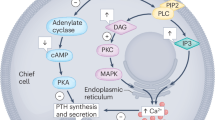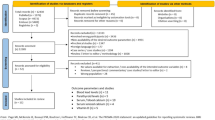Abstract
Plasma parathyroid hormone related-protein (PTHrP) may inhibit the calcium-lowering effect of bisphosphonate therapy. In this prospective study we examined the relationship between plasma PTHrP levels, renal tubular markers of calcium reabsorption, and the effectiveness of intravenous bisphosphonate therapy (IVBPT) in lowering serum calcium in patients with hypercalcaemia of malignancy (HM), with and without bone metastases. Thirty-five symptomatic hypercalcaemic patients (17 without and 18 with bone metastases) were treated with IVBPT (pamidronate 30-60 mg or BM21.0955 2-6 mg). Normocalcaemia was achieved in 24/35 (71%) patients with a mean fall in serum calcium of 0.85 mmol l-1 (range 0.11-1.93, P < 0.001). In the 35 patients studied, serum calcium levels reached a nadir between days 3 and 7, and this was accompanied by a small but significant reduction in plasma PTHrP levels (median reduction 0.77 pmol l-1, P = 0.007). Patients who responded to bisphosphonate therapy by becoming normocalcaemic had significantly lower basal plasma PTHrP levels, mean 4.06 vs 8.2 pmol l-1 (P < 0.04). A significant reduction in urinary calcium excretion was seen (mean 106 mumol l-1, P < 0.02) in patients with bone metastases, and urinary cAMP (mean 170 mmol l-1, P < 0.01) fell in all patients. Patients without demonstrable bone metastases had significantly higher plasma PTHrP levels (P < 0.002), required more doses of IVBPT, and had a poorer reduction in serum calcium compared with patients with bone metastases, only one of whom required more than one dose. We conclude that circulating PTHrP has an important role in increasing renal tubular reabsorption of calcium in HM, thus reducing the effectiveness of bisphosphonate therapy, particularly in patients with humoral HM and no bone metastases.
This is a preview of subscription content, access via your institution
Access options
Subscribe to this journal
Receive 24 print issues and online access
$259.00 per year
only $10.79 per issue
Buy this article
- Purchase on SpringerLink
- Instant access to full article PDF
Prices may be subject to local taxes which are calculated during checkout
Similar content being viewed by others
Author information
Authors and Affiliations
Rights and permissions
About this article
Cite this article
Walls, J., Ratcliffe, W., Howell, A. et al. Response to intravenous bisphosphonate therapy in hypercalcaemic patients with and without bone metastases: the role of parathyroid hormone-related protein. Br J Cancer 70, 169–172 (1994). https://doi.org/10.1038/bjc.1994.270
Issue date:
DOI: https://doi.org/10.1038/bjc.1994.270
This article is cited by
-
Cancer-associated hypercalcemia treated with intravenous diphosphonates: a survival and prognostic factor analysis
Supportive Care in Cancer (2008)
-
Hypercalcemia in Breast Cancer: An Echo of Bone Mobilization During Lactation?
Journal of Mammary Gland Biology and Neoplasia (2005)



